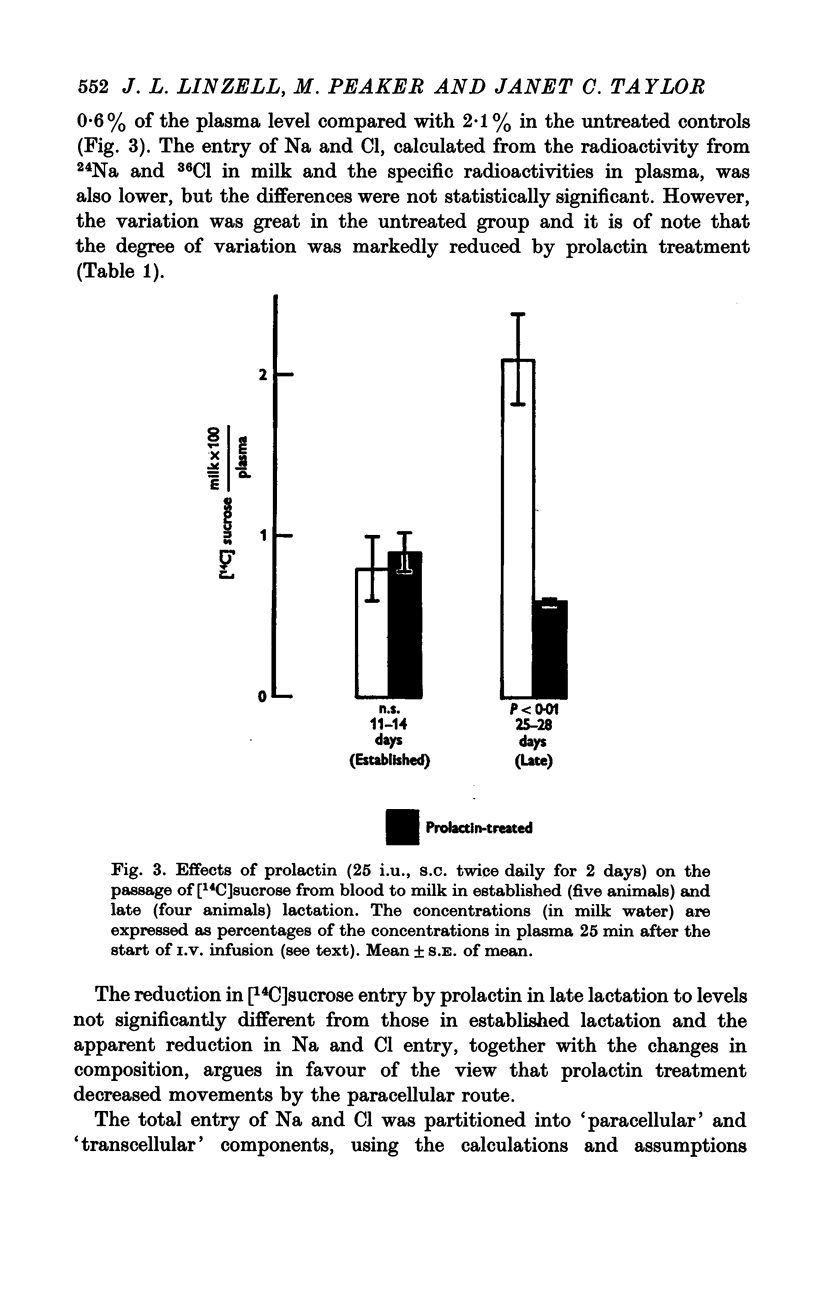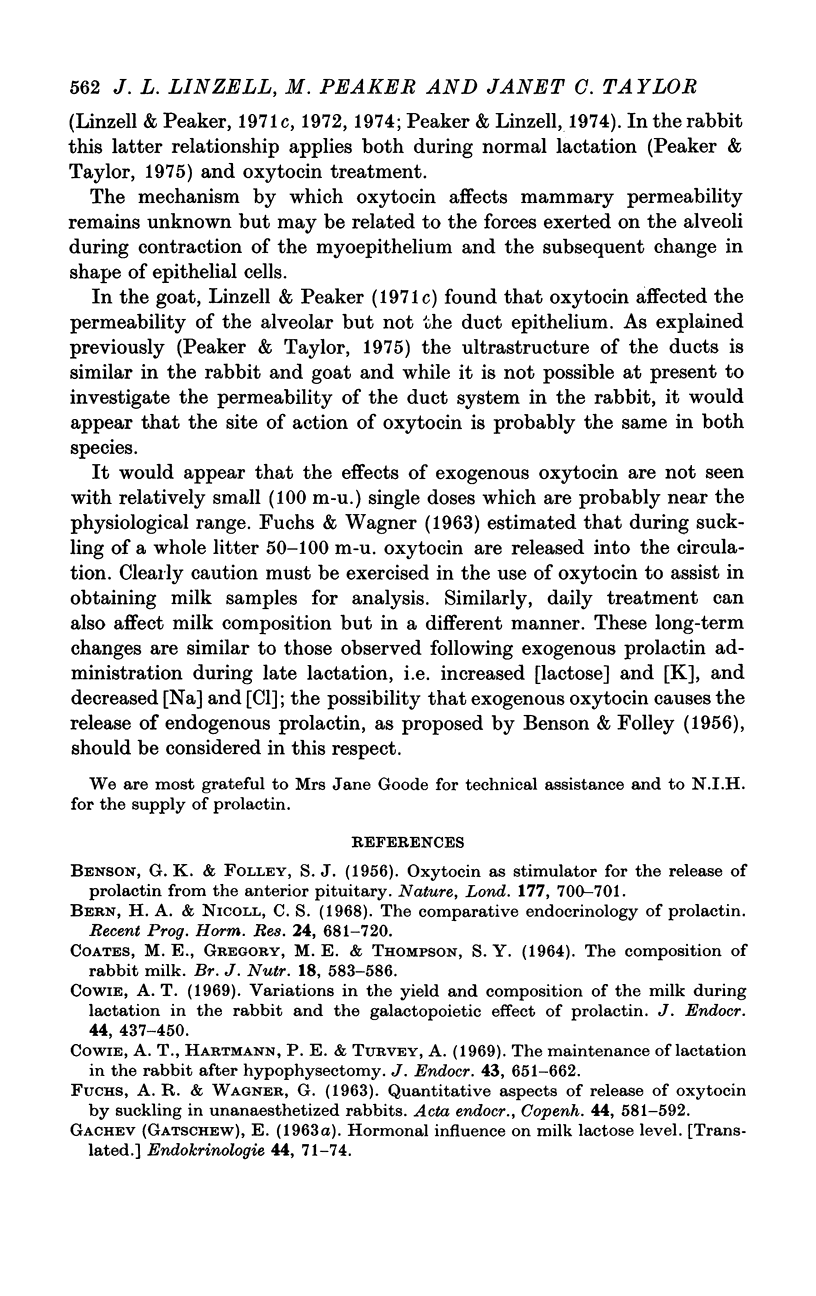Abstract
The effects of prolactin or oxytocin on milk secretion and the permeability of the mammary epithelium have been investigated in rabbits. 2. Milk yield was increased by prolactin treatment in late (25-28 days) but not in established (11-14 days) lactation. 3. Prolactin treatment increased milk [lactose] and [K] and decreased [Na] and [Cl] in late lactation, and thus reversed the normal changes in late lactation, but had no significant effect in established lactation. 4. [14C]sucrose movements from blood to milk were significantly decreased to levels characteristic of established lactation, following prolactin treatment in late lactation. No significant effect was evident with treatment in established lactation. Na and Cl movements showed similar trends. 5. It is suggested that prolactin in some way affects paracellular movements of ions and small molecules like lactose across the mammary epithelium, and that this mechanism is responsible for the changes in the composition of the aqueous phase of milk. 6. Immediately following a single dose of 100 m-u. oxytocin no significant effects on milk composition were evident but after 1 u. milk [Na] and [cl] were significantly increased. 7. Twenty-four hr after 1 u. oxytocin, milk [Na] and [cl] were decreased while [K], [lactose], [fat] and [protein] were increased. 8. During an I.V. infusion of oxytocin milk [Na] and [Cl] increased while [K] and [lactose] decreased. The passage of [(14)C]sucrose, 24Na and (36)Cl from blood to milk also increased. 9. These effects of oxytocin are discussed in relation to the permeability of the mammary epithelium and the pathways for ion movements, and to other studies on milk composition in the rabbit involving the administration of oxytocin to aid in the evacuation of milk.
Full text
PDF
















Selected References
These references are in PubMed. This may not be the complete list of references from this article.
- BENSON G. K., FOLLEY S. J. Oxytocin as stimulator for the release of prolactin from the anterior pituitary. Nature. 1956 Apr 14;177(4511):700–700. doi: 10.1038/177700a0. [DOI] [PubMed] [Google Scholar]
- Bern H. A., Nicoll C. S. The comparative endocrinology of prolactin. Recent Prog Horm Res. 1968;24:681–720. doi: 10.1016/b978-1-4831-9827-9.50019-8. [DOI] [PubMed] [Google Scholar]
- COATES M. E., GREGORY M. E., THOMPSON S. Y. THE COMPOSITION OF RABBIT'S MILK. Br J Nutr. 1964;18:583–586. doi: 10.1079/bjn19640051. [DOI] [PubMed] [Google Scholar]
- Cowie A. T., Hartmann P. E., Turvey A. The maintenance of lactation in the rabbit after hypophysectomy. J Endocrinol. 1969 Apr;43(4):651–662. doi: 10.1677/joe.0.0430651. [DOI] [PubMed] [Google Scholar]
- Cowie A. T. Variations in the yield and composition of the milk during lactation in the rabbit and the galactopoietic effect of prolactin. J Endocrinol. 1969 Jul;44(3):437–450. doi: 10.1677/joe.0.0440437. [DOI] [PubMed] [Google Scholar]
- FUCHS A. R., WAGNER G. QUANTITATIVE ASPECTS OF RELEASE OF OXYTOCIN BY SUCKLING IN UNANAESTHETIZED RABBITS. Acta Endocrinol (Copenh) 1963 Dec;44:581–592. doi: 10.1530/acta.0.0440581. [DOI] [PubMed] [Google Scholar]
- GACHEV E. P. ROL' PROLAKTINA V PODDERZHANII UROVNIA LAKTOZY V MOLOKE. Zh Obshch Biol. 1963 Sep-Oct;24:382–383. [PubMed] [Google Scholar]
- Linzell J. L., Peaker M. Changes in colostrum composition and in the permeability of the mammary epithelium at about the time of parturition in the goat. J Physiol. 1974 Nov;243(1):129–151. doi: 10.1113/jphysiol.1974.sp010746. [DOI] [PMC free article] [PubMed] [Google Scholar]
- Linzell J. L., Peaker M. Day-to-day variations in milk composition in the goat and cow as a guide to the detection of subclinical mastitis. Br Vet J. 1972 Jun;128(6):284–295. doi: 10.1016/s0007-1935(17)36932-4. [DOI] [PubMed] [Google Scholar]
- Linzell J. L., Peaker M. Intracellular concentrations of sodium, potassium and chloride in the lactating mammary gland and their relation to the secretory mechanism. J Physiol. 1971 Aug;216(3):683–700. doi: 10.1113/jphysiol.1971.sp009547. [DOI] [PMC free article] [PubMed] [Google Scholar]
- Linzell J. L., Peaker M. Mechanism of milk secretion. Physiol Rev. 1971 Jul;51(3):564–597. doi: 10.1152/physrev.1971.51.3.564. [DOI] [PubMed] [Google Scholar]
- Linzell J. L., Peaker M. The effects of oxytocin and milk removal on milk secretion in the goat. J Physiol. 1971 Aug;216(3):717–734. doi: 10.1113/jphysiol.1971.sp009549. [DOI] [PMC free article] [PubMed] [Google Scholar]
- Linzell J. L. The effect of very frequent milking and of oxytocin on the yield and composition of milk in fed and fasted goats. J Physiol. 1967 May;190(2):333–346. doi: 10.1113/jphysiol.1967.sp008212. [DOI] [PMC free article] [PubMed] [Google Scholar]
- Mena F., Reyes G., Aguayo D., Grosvenor C. E. Effect of acute reduction in milk removal from some glands upon the ability of a single rabbit mammary gland to secrete milk. J Endocrinol. 1974 Sep;62(3):431–438. doi: 10.1677/joe.0.0620431. [DOI] [PubMed] [Google Scholar]
- Peaker M., Linzell J. L. The effects of oestrus and exogenous oestrogens on milk secretion in the goat. J Endocrinol. 1974 May;61(2):231–240. doi: 10.1677/joe.0.0610231. [DOI] [PubMed] [Google Scholar]
- Peaker M., Taylor J. C. Milk secretion in the rabbit: changes during lactation and the mechanism of ion transport. J Physiol. 1975 Dec;253(2):527–545. doi: 10.1113/jphysiol.1975.sp011205. [DOI] [PMC free article] [PubMed] [Google Scholar]
- Taylor J. C., Peaker M., Linzell J. L. Proceedings: Effects of prolactin on ion movements across the mammary epithelium of the rabbit. J Endocrinol. 1975 Jun;65(3):26P–27P. [PubMed] [Google Scholar]
- Zarrow M. X., Denenberg V. H., Anderson C. O. Rabbit: frequency of suckling in the pup. Science. 1965 Dec 31;150(3705):1835–1836. doi: 10.1126/science.150.3705.1835. [DOI] [PubMed] [Google Scholar]


